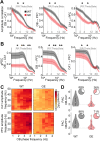Developmental Olfactory Dysfunction and Abnormal Odor Memory in Immune-Challenged Disc1+/- Mice
- PMID: 40447445
- PMCID: PMC12178285
- DOI: 10.1523/JNEUROSCI.1007-24.2025
Developmental Olfactory Dysfunction and Abnormal Odor Memory in Immune-Challenged Disc1+/- Mice
Abstract
Neuronal activity in the olfactory bulb (OB) drives coordinated activity in the hippocampal-prefrontal network during early development. Inhibiting OB output in neonatal mice disrupts functional development of the hippocampal formation as well as cognitive abilities. These impairments manifest early in life and resemble dysfunctions of the hippocampus and the prefrontal cortex that have been linked to neuropsychiatric disorders. Thus, we investigated OB activity during early development in a disease mouse model and asked whether activity disruptions might contribute to the dysfunctional development of the hippocampal-prefrontal network. We addressed this question by combining in vivo electrophysiology with behavioral assessment of immune-challenged Disc1+/- mice of both sexes that mimic the dual genetic-environmental etiology of neuropsychiatric disorders. In wild-type mice, we found high DISC1 expression levels in OB projection neurons during development. Furthermore, neuronal and network activity in the OB and the drive from the bulb to the hippocampal-prefrontal network were reduced in immune-challenged Disc1+/- mice during early development. This early deficit did not affect odor-evoked activity and odor perception but resulted in impaired long-term odor memory. We propose that reduced spontaneous activity in the developing OB might contribute to altered maturation of the hippocampal-prefrontal network, leading to memory impairment in immune-challenged Disc1+/- mice.
Keywords: Disc1; development; hippocampus; neuropsychiatric; olfaction; prefrontal cortex.
Copyright © 2025 Parbst et al.
Conflict of interest statement
The authors declare no competing financial interests.
Figures








Similar articles
-
Odor encoding by fine-timescale spike synchronization patterns in the olfactory bulb.J Neurophysiol. 2025 Jul 1;134(1):274-286. doi: 10.1152/jn.00340.2024. Epub 2025 Jun 14. J Neurophysiol. 2025. PMID: 40517018 Free PMC article.
-
ErbB4 deficiency exacerbates olfactory dysfunction in an early-stage Alzheimer's disease mouse model.Acta Pharmacol Sin. 2024 Dec;45(12):2497-2512. doi: 10.1038/s41401-024-01332-6. Epub 2024 Jul 9. Acta Pharmacol Sin. 2024. PMID: 38982150
-
Transient Knock-Down of Prefrontal DISC1 in Immune-Challenged Mice Causes Abnormal Long-Range Coupling and Cognitive Dysfunction throughout Development.J Neurosci. 2019 Feb 13;39(7):1222-1235. doi: 10.1523/JNEUROSCI.2170-18.2018. Epub 2019 Jan 7. J Neurosci. 2019. PMID: 30617212 Free PMC article.
-
A systematic-review of olfactory deficits in neurodevelopmental disorders: From mouse to human.Neurosci Biobehav Rev. 2021 Jun;125:110-121. doi: 10.1016/j.neubiorev.2021.02.024. Epub 2021 Feb 18. Neurosci Biobehav Rev. 2021. PMID: 33610612 Free PMC article.
-
How early olfactory experiences influence brain development in mice.Front Neural Circuits. 2025 Jun 10;19:1608270. doi: 10.3389/fncir.2025.1608270. eCollection 2025. Front Neural Circuits. 2025. PMID: 40557113 Free PMC article. Review.
References
MeSH terms
Substances
LinkOut - more resources
Full Text Sources
Medical
Molecular Biology Databases
Miscellaneous
